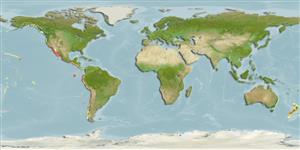>
Acanthuriformes (Surgeonfishes) >
Chaetodontidae (Butterflyfishes)
Etymology: Prognathodes: Greek, pro = first, in front of + Greek, gnathos = jaw (Ref. 45335); falcifer: Chaetodon meaning bristle tooth, falcifer meaning scythe-bearer (Ref. 4930).
More on authors: Hubbs & Rechnitzer.
Environment: milieu / climate zone / depth range / distribution range
Ecologia
marinhas associadas(os) a recifes; intervalo de profundidade 10 - 150 m. Subtropical
Eastern Pacific: Santa Catalina Island, southern California, USA to Peru, including the Galapagos Islands.
Tamanho / Peso / Idade
Maturity: Lm ? range ? - ? cm
Max length : 15.0 cm TL macho/indeterminado; (Ref. 9286)
Descrição suscinta
Chaves de identificação | Morfologia | Morfometria
Espinhos dorsais (total) : 12; Raios dorsais (total) : 19 - 20; Espinhos anais: 3; Raios anais : 14 - 16.
Usually solitary. Found in rocky, boulder strewn areas (Ref. 5227). Close relatives are known to pinch off and eat tube feet of sea urchins and other echinoderms. Also feed on crustaceans, worms and other small invertebrates (Ref. 4930). Because they live in relatively deeper waters, they are seldom collected, thus, rarely seen in the aquarium trade (Ref. 4930). Oviparous (Ref. 205). Form pairs during breeding (Ref. 205).
Ciclo de vida ou comportamento de acasalamento
Maturidade | Reprodução | Desova | Ovos | Fecundidade | Larvas
Form pairs during breeding (Ref. 205).
Allen, G.R., 1985. Butterfly and angelfishes of the world. Vol. 2. 3rd edit. in English. Mergus Publishers, Melle, Germany. (Ref. 4858)
Status na Lista Vermelha da UICN (Ref. 130435: Version 2024-2)
Ameaça para os humanos
Harmless
Uso pelos humanos
Pescarias: espécies comerciais; Aquário: Espécies comerciais
Ferramentas
Relatórios especiais
Baixar XML
Fontes da internet
Estimates based on models
Preferred temperature (Ref.
123201): 14.2 - 22.9, mean 16.9 °C (based on 40 cells).
Índice de diversidade filogenética (Ref.
82804): PD
50 = 0.5002 [Uniqueness, from 0.5 = low to 2.0 = high].
Bayesian length-weight: a=0.02239 (0.01097 - 0.04568), b=3.01 (2.84 - 3.18), in cm total length, based on LWR estimates for this (Sub)family-body shape (Ref.
93245).
Nível Trófico (Ref.
69278): 3.3 ±0.34 se; based on food items.
Resiliência (Ref.
120179): Elevada, tempo mínimo de duplicação da população menor que 15 meses (Preliminary K or Fecundity.).
Fishing Vulnerability (Ref.
59153): Low vulnerability (10 of 100).
Nutrients (Ref.
124155): Calcium = 64.6 [28.6, 132.6] mg/100g; Iron = 0.852 [0.454, 1.592] mg/100g; Protein = 19.3 [18.0, 20.5] %; Omega3 = 0.213 [0.111, 0.406] g/100g; Selenium = 21 [9, 45] μg/100g; VitaminA = 29.5 [6.8, 126.0] μg/100g; Zinc = 0.963 [0.587, 1.498] mg/100g (wet weight);
